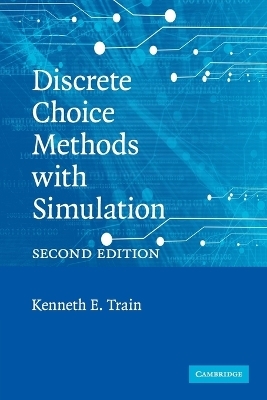
Discrete Choice Methods with Simulation
Cambridge University Press (Verlag)
978-0-521-74738-7 (ISBN)
This book describes the new generation of discrete choice methods, focusing on the many advances that are made possible by simulation. Researchers use these statistical methods to examine the choices that consumers, households, firms, and other agents make. Each of the major models is covered: logit, generalized extreme value, or GEV (including nested and cross-nested logits), probit, and mixed logit, plus a variety of specifications that build on these basics. Recent advances in Bayesian procedures are explored, including the use of the Metropolis-Hastings algorithm and its variant Gibbs sampling. This second edition adds chapters on endogeneity and expectation-maximization (EM) algorithms. No other book incorporates all these fields, which have arisen in the past 25 years. The procedures are applicable in many fields, including energy, transportation, environmental studies, health, labor, and marketing.
This book describes the new generation of discrete choice methods, focusing on the many advances that are made possible by simulation. Researchers use these statistical methods to examine the choices that consumers, households, firms, and other agents make. Each of the major models is covered: logit, generalized extreme value or GEV (including nested and cross-nested logits), probit, and mixed logit, plus a variety of specifications that build on these basics. Simulation-assisted estimation procedures are investigated and compared, including maximum stimulated likelihood, method of simulated moments, and method of simulated scores. Procedures for drawing from densities are described, including variance reduction techniques such as anithetics and Halton draws. Recent advances in Bayesian procedures are explored, including the use of the Metropolis-Hastings algorithm and its variant Gibbs sampling. The second edition adds chapters on endogeneity and expectation-maximization (EM) algorithms. No other book incorporates all these fields, which have arisen in the past 25 years. The procedures are applicable in many fields, including energy, transportation, environmental studies, health, labor, and marketing.
1. Introduction; Part I. Behavioral Models: 2. Properties; 3. Logit; 4. GEV; 5. Probit; 6. Mixed logit; 7. Variations on a theme; Part II. Estimation: 8. Numerical maximization; 9. Drawing from densities; 10. Simulation-assisted estimation; 11. Individual-level parameters; 12. Bayesian procedures; 13. Endogeneity; 14. EM algorithms.
| Zusatzinfo | 17 Tables, unspecified; 46 Line drawings, unspecified |
|---|---|
| Verlagsort | Cambridge |
| Sprache | englisch |
| Maße | 152 x 229 mm |
| Gewicht | 530 g |
| Themenwelt | Mathematik / Informatik ► Mathematik |
| Wirtschaft ► Volkswirtschaftslehre ► Ökonometrie | |
| ISBN-10 | 0-521-74738-4 / 0521747384 |
| ISBN-13 | 978-0-521-74738-7 / 9780521747387 |
| Zustand | Neuware |
| Haben Sie eine Frage zum Produkt? |
aus dem Bereich



